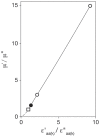Adaptation of mycobacteria to growth conditions: a theoretical analysis of changes in gene expression revealed by microarrays
- PMID: 23593152
- PMCID: PMC3625197
- DOI: 10.1371/journal.pone.0059883
Adaptation of mycobacteria to growth conditions: a theoretical analysis of changes in gene expression revealed by microarrays
Abstract
Background: Microarray analysis is a powerful technique for investigating changes in gene expression. Currently, results (r-values) are interpreted empirically as either unchanged or up- or down-regulated. We now present a mathematical framework, which relates r-values to the macromolecular properties of population-average cells. The theory is illustrated by the analysis of published data for two species; namely, Mycobacterium bovis BCG Pasteur and Mycobacterium smegmatis mc(2) 155. Each species was grown in a chemostat at two different growth rates. Application of the theory reveals the growth rate dependent changes in the mycobacterial proteomes.
Principal findings: The r-value r (i) of any ORF (ORF(i)) encoding protein p (i) was shown to be equal to the ratio of the concentrations of p (i) and so directly proportional to the ratio of the numbers of copies of p (i) per population-average cells of the two cultures. The proportionality constant can be obtained from the ratios DNA: RNA: protein. Several subgroups of ORFs were identified because they shared a particular r-value. Histograms of the number of ORFs versus the expression ratio were simulated by combining the particular r-values of several subgroups of ORFs. The largest subgroup was ORF(j) (r (j) = 1.00± SD) which was estimated to comprise respectively 59% and 49% of ORFs of M. bovis BCG Pasteur and M. smegmatis mc(2) 155. The standard deviations reflect the properties of the cDNA preparations investigated.
Significance: The analysis provided a quantitative view of growth rate dependent changes in the proteomes of the mycobacteria studied. The majority of the ORFs were found to be constitutively expressed. In contrast, the protein compositions of the outer permeability barriers and cytoplasmic membranes were found to be dependent on growth rate; thus illustrating the response of bacteria to their environment. The theoretical approach applies to any cultivatable bacterium under a wide range of growth conditions.
Conflict of interest statement
Figures





Similar articles
-
par genes in Mycobacterium bovis and Mycobacterium smegmatis are arranged in an operon transcribed from "SigGC" promoters.BMC Microbiol. 2008 Mar 27;8:51. doi: 10.1186/1471-2180-8-51. BMC Microbiol. 2008. PMID: 18371202 Free PMC article.
-
Transcription analysis of the dnaA gene and oriC region of the chromosome of Mycobacterium smegmatis and Mycobacterium bovis BCG, and its regulation by the DnaA protein.Microbiology (Reading). 2003 Mar;149(Pt 3):773-784. doi: 10.1099/mic.0.25832-0. Microbiology (Reading). 2003. PMID: 12634345
-
The porin MspA from Mycobacterium smegmatis improves growth of Mycobacterium bovis BCG.Int J Med Microbiol. 2004 Oct;294(4):235-45. doi: 10.1016/j.ijmm.2004.02.001. Int J Med Microbiol. 2004. PMID: 15532981
-
Polycysteine-encoding leaderless short ORFs function as cysteine-responsive attenuators of operonic gene expression in mycobacteria.Mol Microbiol. 2020 Jul;114(1):93-108. doi: 10.1111/mmi.14498. Epub 2020 Apr 9. Mol Microbiol. 2020. PMID: 32181921 Free PMC article.
-
The SigF regulon in Mycobacterium smegmatis reveals roles in adaptation to stationary phase, heat, and oxidative stress.J Bacteriol. 2010 May;192(10):2491-502. doi: 10.1128/JB.00035-10. Epub 2010 Mar 16. J Bacteriol. 2010. PMID: 20233930 Free PMC article.
Cited by
-
Nontuberculous Mycobacteria Prevalence in Bats' Guano from Caves and Attics of Buildings Studied by Culture and qPCR Examinations.Microorganisms. 2021 Oct 27;9(11):2236. doi: 10.3390/microorganisms9112236. Microorganisms. 2021. PMID: 34835362 Free PMC article.
-
Structome analysis of virulent Mycobacterium tuberculosis, which survives with only 700 ribosomes per 0.1 fl of cytoplasm.PLoS One. 2015 Jan 28;10(1):e0117109. doi: 10.1371/journal.pone.0117109. eCollection 2015. PLoS One. 2015. PMID: 25629354 Free PMC article.
-
Ms1, a novel sRNA interacting with the RNA polymerase core in mycobacteria.Nucleic Acids Res. 2014 Oct;42(18):11763-76. doi: 10.1093/nar/gku793. Epub 2014 Sep 12. Nucleic Acids Res. 2014. PMID: 25217589 Free PMC article.
References
-
- Kendall SL, Rison SC, Movahedzadeh F, Frita R, Stoker NG (2004a) What do microarrays really tell us about Mycobacterium tuberculosis?. Trends Microbiol 12: 537–544. - PubMed
-
- Blattner FR, Plunkett G III, Bloch CA, Perna NT, Burland V, et al. (1997) The complete genome sequence of Escherichia coli K-12. Science 277: 1453–1474. - PubMed
-
- Southern EM (2001) DNA microarrays. History and overview Methods Mol Biol. 170: 1–15. - PubMed
-
- Cole ST, Brosch R, Parkhill J, Garnier T, Churcher C, et al. (1998) Deciphering the biology of Mycobacterium tuberculosis from the complete genome sequence. Nature 393: 537–544. - PubMed
-
- Cole ST, Eiglmeier K, Parkhill J, James KD, Thomson NR, et al. (2001) Massive gene decay in the leprosy bacillus. Nature 409: 1007–1011. - PubMed
MeSH terms
Substances
LinkOut - more resources
Full Text Sources
Other Literature Sources

